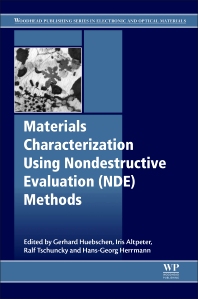LIMITED OFFER
Save 50% on book bundles
Immediately download your ebook while waiting for your print delivery. No promo code is needed.
Materials Characterization Using Nondestructive Evaluation (NDE) Methods discusses NDT methods and how they are highly desirable for both long-term monitoring and short-ter… Read more

LIMITED OFFER
Immediately download your ebook while waiting for your print delivery. No promo code is needed.
Materials Characterization Using Nondestructive Evaluation (NDE) Methods
discusses NDT methods and how they are highly desirable for both long-term monitoring and short-term assessment of materials, providing crucial early warning that the fatigue life of a material has elapsed, thus helping to prevent service failures.Materials Characterization Using Nondestructive Evaluation (NDE) Methods gives an overview of established and new NDT techniques for the characterization of materials, with a focus on materials used in the automotive, aerospace, power plants, and infrastructure construction industries.
Each chapter focuses on a different NDT technique and indicates the potential of the method by selected examples of applications. Methods covered include scanning and transmission electron microscopy, X-ray microtomography and diffraction, ultrasonic, electromagnetic, microwave, and hybrid techniques. The authors review both the determination of microstructure properties, including phase content and grain size, and the determination of mechanical properties, such as hardness, toughness, yield strength, texture, and residual stress.
civil, structural and mechanical engineers, materials scientists, physicists developing characterization techniques, and R&D managers in the automotive and aerospace and power generation industry.
1. Atomic force microscopy (AFM) for materials characterization
2. Scanning electron microscopy (SEM) and transmission electron microscopy (TEM) for materials characterization
3. X-ray microtomography for materials characterization
4. X-ray diffraction (XRD) techniques for materials characterization
5. Microwave, millimeter wave and terahertz (MMT) techniques for materials characterization
6. Acoustic microscopy for materials characterization
7. Ultrasonic techniques for materials characterization
8. Electromagnetic techniques for materials characterization
9. Hybrid methods for materials characterization
GH
IA
RT
HH